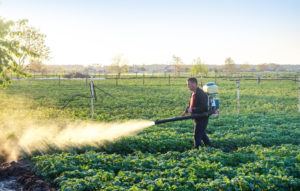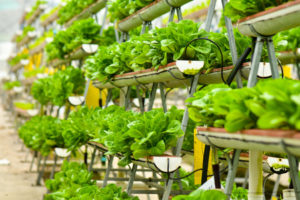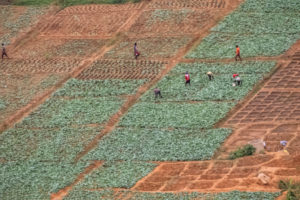
Vertical farming, a phenomenon that has slowly gained traction since 1999, shows us that there are always going to be innovative ways to increase our food production. With the global population steadily increasing, there is a lot of attention being turned towards the controversial debate of vertical farming versus traditional farming and which will save us in the end.
It has been found that vertical farming on average produces 240 times more crop yield while using 99% less land. Also, vertical farming uses 95% less water and zero chemicals. The benefits seen here would lead many to conclude that vertical farming is superior to traditional farming.
Despite the obvious pros to vertical farming, there is still more that remains to be seen. Vertical farming does have its disadvantages and weak places where traditional farming can triumph and come out on top. In this article, we will be discussing the advantages and disadvantages of both, as well as giving a deeper understanding of the impacts of both methods
Vertical Farming or Traditional Farming?
There is a crisis on the way that not many people are aware of. As the earth’s population increases, so should the food production levels. But unfortunately, that isn’t happening and we have seen 30% of our arable land become unusable in the last forty years. Should this trend continue, we humans are going to have a real problem on our hands.
One of the solutions to this problem was vertical farming. Variations of this technique have been seen historically for a long time, but the potential wasn’t fully appreciated until 1999 when a professor at Columbia university fleshed out the idea. Once he had come up with how a commercial vertical farm would operate in 2001, the idea took off, and now we see it becoming more and more popular.
Traditional farming is what we are all familiar with. We know it, we understand it, and to us it is natural. The idea of growing our food in a warehouse with the help of LED lights is not very inviting nor does it convey the idea of “fresh foods”. Instead, when thinking of food that is grown in a ‘lab’ of sorts, many would think the food would taste undesirable.
Impacts of Vertical Farming
Vertical farming is the solution to the unrealized problem of more and more people migrating to urban areas. How are we to feed them, and how are we to feed them fresh foods? Vertical farming uses two methods to achieve the answer to these questions. There is the wall-mounted system and there is the multi-layered system that incorporates several stories of a warehouse

Despite how the farmer chooses to order his plants, he or she is going to use one of three growing systems: hydroponics, aquaponics, and aeroponics. Hydroponics is the most common form of growing indoor plants, and its process is to eliminate soil out of the equation. Instead, it achieves plant growth by submerging the plant in a mineral nutrient solution. That solution is monitored to ensure that the plant is receiving all that it needs.
To get started in hydroponics, I can recommend this complete kit and some seeds so you can start growing amazing food in your home.
Aquaponics is the lesser used of the three but has some interesting elements that are sure to catch your attention. This method brings together fish and plants, making them a dynamic duo that survives off the other. Nutrient-rich waste is produced by the fish’s ecosystem, therefore making it ideal plant food. The plants then filter out this water and purify it; after this happens the water is sent back to the fish, creating a cycle.
Aeroponics is a method that uses 90% less water, as instead of the previous two systems, it relies heavily on an air and mist environment. As the roots would also be soil-free, the mist would be heavily infused with nutrients and give the naked roots a puff every so often. With 70% of the world’s water going towards traditional agriculture every year, this method would be extremely valuable. Source
| Pros | Cons |
| Year-Round Crop production: As this technique is indoors, growth could be constant. Crop yield would also amount to more than that of traditional, as one acre of vertical farming is the equivalent of 30 acres of traditional farming. | Costs to pollinate the plants manually would grow to be very expensive and not time-efficient. This would require more human-to-plant contact. |
| Zero pesticides and chemicals are used because of the controlled environment for the plants. | Should the building lose power, just one day of lost power would be a devastating loss for the vertical farm. |
| Since 95% less water is used, that water can be redirected to other areas of life where it is necessary. | Not as much variety can be found in vertical farming yet, as some plant types take too long or are not ideal for the process. |
| The cost of land is increasing, especially around urban areas. This method would allow for people to create vertical farms in any empty office, abandoned warehouse, and even shipping containers. | Some argue that the crops produced here are not organic, because they weren’t grown by natural means |
| Fresher foods for urban areas are now possible because the foods can be grown right by or within city limits. | The buildings and technology that go into this system are costly. |
Impacts of Traditional Farming
Several practices go into traditional farming. Crop rotation, intercropping, and cover cropping are just some of the techniques used to get the food we eat today. Once farmers came to understand more about how chemistry could better influence crop production, we saw an increase in chemicals being used to prevent disease and control pests in our crops.

Crop rotation is a method that has the same land being used for a series of different plants, depending on the season. Such a method preserves the soil productivity, eliminates the need for so many chemicals, and maximizes the crop yield.
Intercropping is similar to crop rotation but instead does what crop rotation does all at the same time. It is growing two or more different seeds on the same land at the same time. This happens either by alternating rows or having different sections. Intercropping creates biodiversity and reduces pests.
 Shop The Farmstand – Self-Watering, Self-Fertilizing Solution for an Easy to Grow Harvest
Shop The Farmstand – Self-Watering, Self-Fertilizing Solution for an Easy to Grow Harvest
Cover cropping is to grow soil, not food. This method is distinctive in that it isn’t for our use, but to better our soil, thereby bettering our crop production. It’s a natural way to enrich the soil and provide better results in farming. The plants for cover cropping are planted merely to cover the soil and then manage soil erosion, soil fertility, diseases, etc. Source
| Pros | Cons |
| Far more accessible for poorer countries | Requires attention 24/7 and can be exhausting. More often than not farmers don’t get back all that they put in |
| Far more employment opportunities are seen here as more manual labor is required | As more agriculture is dominated by commercial farms, the family farm is seen less and less |
| Uses far less energy because the crops rely on solar energy. It is also not reliant on energy, unlike vertical farming | Uses pesticides and chemicals which people don’t like |
Although traditional farming is the backbone of agriculture, and what most people will cling to because of its inherent familiarity, vertical farming appears to take the win here. On almost every topic it conquers traditional farming. From seeing an increase in crop production in such a small area of land to using little to no water, this method will continue to evolve and change the world for the better.
